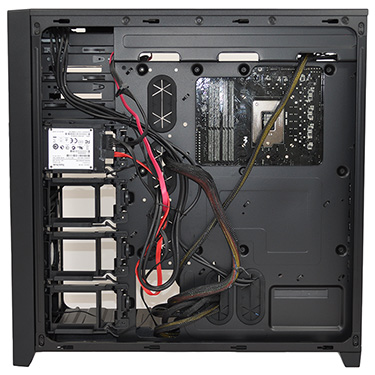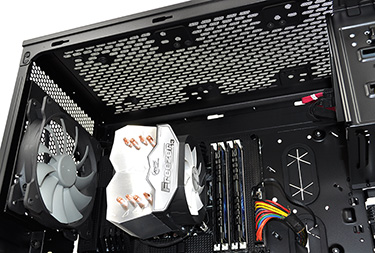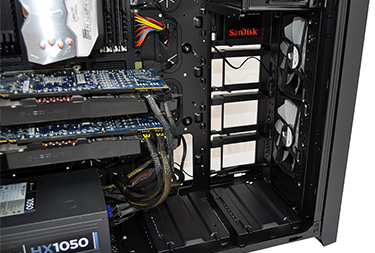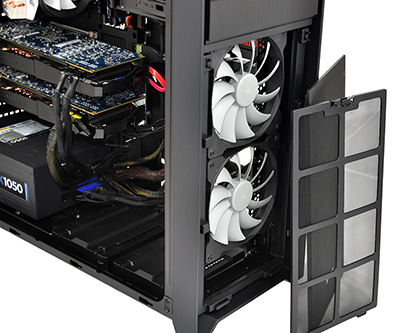In And Around The 750D
The 750D's interior sounds fantastic - and in most aspects it is - however it comes with a rather-large caveat. If, like us, you're a fan of Corsair's quick-release side panels, you're in for a disappointment as they don't feature on the 750D.
Instead of following in the footsteps of the 900D, 800D, 700D, 650D and 550D - all of which came equipped with quick-release panels - the 750D uses hinged panels that are secured with plain ol' thumb screws. It's unlikely to matter to users who rarely stray into the confines of their rig, but if you're in and out of your chassis on a frequent basis, it feels like a massive downgrade.
Fumbling with misaligned side panels is a common source of chassis frustration, and given the size of the 750D panels, it's a surprise Corsair hasn't chosen a more user-friendly mechanism. What's interesting is that the chassis' sides have unused slots at the top and bottom. These are typically used to secure notched side panels, but the fact that Corsair's hinged panels don't use them suggests that the company had a late change of heart. Worth noting, also, that with the panels secured at the front (hinge) and back (thumb screws) there's always the possibility of a bulge in the middle if there's a huge amount of excess cabling.
Get past the side-panel disappointment and there's plenty to like on the inside. Corsair's interior is attractive and logically laid-out, with a range of features designed to suit enthusiast builds.
Storage typically plays a big part in modern builds and the 750D's drive-bay configuration is flexible to every users' needs. The storage column is topped by a trio of tool-free optical bays, beneath which are four 2.5in trays stacked on their side one above the other. Accessed via the rear side panel, the plastic trays are tool-free, easily removable and generally well-implemented. We quite like the fact that they allow your SSDs to be on display, and they're far back enough not to interfere with radiator installations.
Along the base of the chassis, next to the power supply mount, are two standoffs for the modular 3.5in drive cages. These can be stacked on top of one another, placed side by side or removed altogether, as per the configuration pictured above. Corsair's plastic 3.5in drive trays haven't changed - they still feel basic - but they do offer 2.5in mounting points, so you could, if you have the funds, equip the 750D with up to 10, 2.5in SSDs.
It's fair to assume that most users will be kitting-out the chassis with their own cooling equipment, but there's no hurry to upgrade as the out-the-box setup isn't bad. Corsair includes a trio of 140mm fans (models (AF140L) configured as two front intakes and a single rear exhaust.
Perusing all of the chassis' available fan locations reveals a 120/140mm rear exhaust, three 120mm or two 140mm mounts up top, two 140mm mounts in front and, after removing the drive-cage stands, two 120mm mounts at the bottom. For the liquid-cooling aficionados, that means support for up to three radiators - a 360mm rad up top, a 280mm rad up front, and a 240mm rad at the bottom.
The front fans are protected by a pull-out filter that's hidden neatly behind the push-to-release aluminium fascia, and the top mounts are covered by a magnetic filter that fits securely. These are expected features at this price point, though it's a shame Corsair hasn't provided a filter for the optional bottom fan mounts; we'd like to have seen the pull-out PSU filter extend across the entire length of the chassis.
The 750D's focus, it seems, is to facilitate a high-end build without too many frills. The chassis feels roomy throughout, there's a good amount of room behind the motherboard tray for excess cabling, the massive cutout makes light work of CPU cooler installation, and there are five well-sized and rubber-grommeted holes for cable routing.
Given the price point, it's perhaps no surprise to find that the 750D misses out on a couple of features available to the premium 900D. In addition to the absence of quick-release side panels, the built-in cable clamps behind the motherboard tray are gone, there are no hot-swappable drive bays, and the interior isn't compartmentalised.
It's all surprisingly simple for an Obsidian. The front I/O panel doesn't stray too far from the norm and serves up four USB ports (only two of the SuperSpeed variety) alongside a pair of audio jacks, and the 5.25in bay covers are still far from perfect; install an optical drive and the chassis' frontal appearance is somewhat compromised.
The 750D doesn't feel as ambitious as its 900D, 800D and 700D brethren, and though this is a voluminous chassis capable of housing extreme builds with ease, it's lacking a bit of the star quality we've come to expect from the Obsidian line. Corsair's obviously attempting to hit a more attractive price point, but it's a fine line to walk - mainstream consumers are going to appreciate the new approach, but die-hard users might have preferred to pay extra for the Obsidian Series features they've come to know and appreciate.
What Corsair has done, however, is bring high-end capability to a wider audience. For well under £150, the Obsidian 750D is sturdy, well built, spacious and able to accommodate even the most extreme liquid-cooling configurations.















